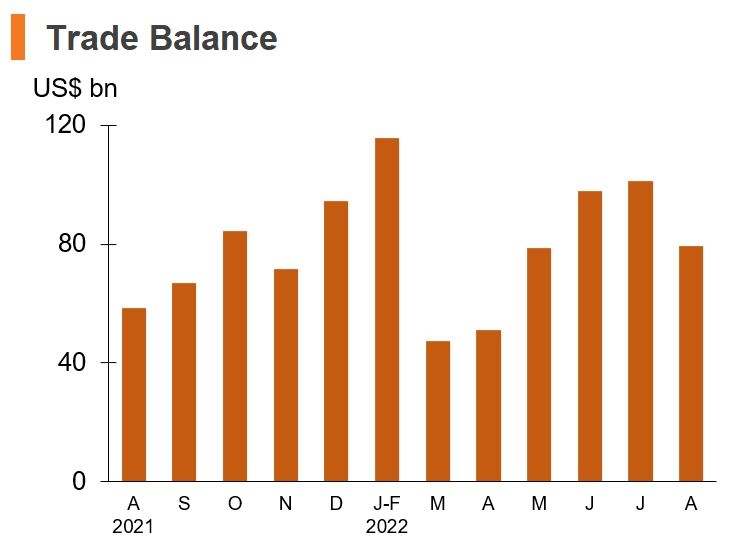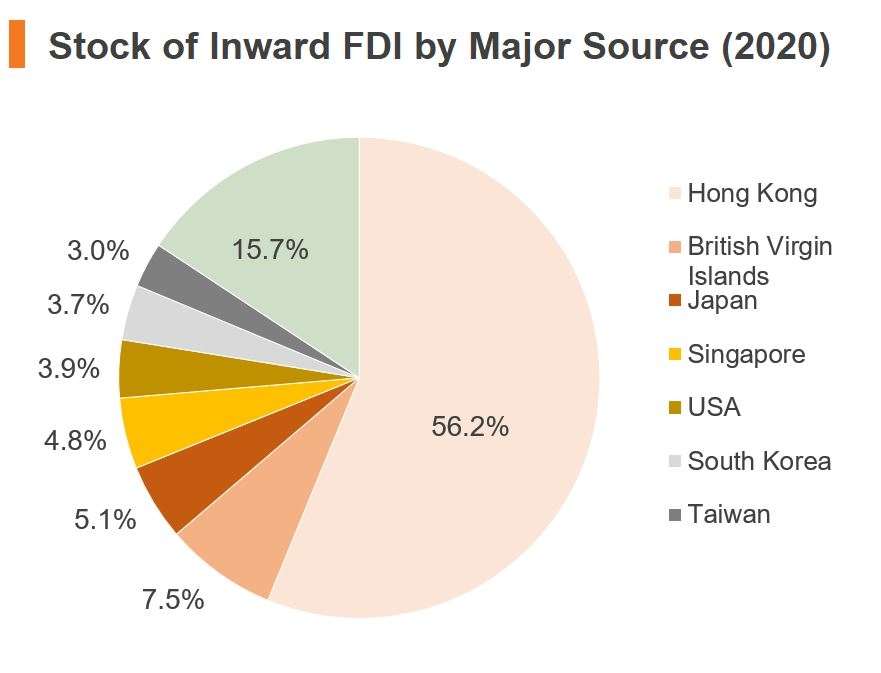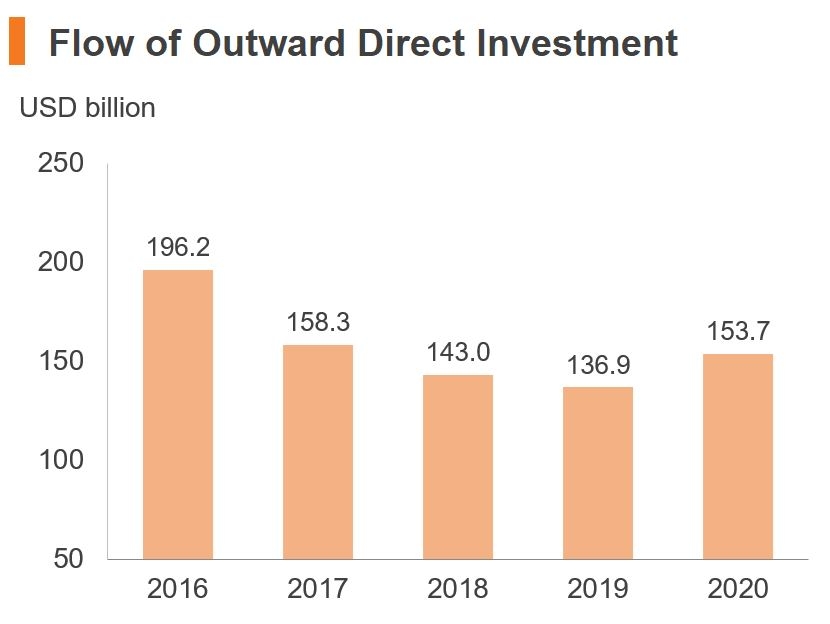Economic and Trade Information on China
Latest development
- In the second quarter of 2022, China’s real GDP grew by 0.4% (year-on-year).
- Added-value industrial output increased by 4.2% in August 2022, up from 3.8% in July 2022 (year-on-year).
- Fixed assets investment increased by 5.8% (year-on-year) Jan-Aug 2022, up from 5.7% (year-on-year) Jan – Jul 2022.
- In August 2022, retail sales increased by 5.4% (year-on-year).
- Inflation increased by 2.5% in August 2022, with food prices up by 6.1% and non-food prices up by 1.7%.
- In August 2022, exports (in terms of US$) increased by 7.1%, while imports (in terms of US$) increased by 0.3%, resulting in a trade surplus of US$79.4 billion.
- The Manufacturing Purchasing Managers’ Index up from 49 in July 2022 to 49.4 in August 2022.
|
Major Economic Indicators |
2021 |
Jan-Aug 2022 |
||
|
Value |
Growth (%) |
Value |
Growth (%) |
|
| Population (mn) |
1,443.5 |
– |
1,443.5 |
– |
| Gross Domestic Product (RMB bn) |
114,367.0 |
8.11 |
56,264.2 |
2.51 |
| GDP Per Capita (RMB) |
80,976 |
8.01 |
– |
– |
| Fixed Assets Investment 2 (RMB bn) |
54,454.7 |
4.9 |
36,710.6 |
5.8 |
| Added-Value of Industrial Output 3 |
– |
9.61 |
– |
3.61 |
| Consumer Goods Retail Sales (RMB bn) |
44,082.3 |
12.5 |
28,256.0 |
0.5 |
| Consumer Price Index |
– |
0.9 |
– |
1.9 |
| Exports (US$ bn) |
3,364.0 |
29.9 |
2,376.0 |
13.5 |
| Imports (US$ bn) |
2,687.5 |
30.1 |
1,815.5 |
4.6 |
| Trade Surplus (US$ bn) |
676.4 |
– |
560.5 |
– |
| Utilised Foreign Direct Investment (US$ bn) |
173.5 |
20.2 |
123.94 |
21.5 |
| Foreign Currency Reserves (US$ bn) |
3,250.2 |
1.0 |
3,054.9 |
-5.5 |
| Note: 1 Real growth 2 Urban investments in fixed assets 3 All state-owned and other types of enterprises with annual sales over RMB 20 million 4 July 2022
Sources: The National Bureau of Statistics, Ministry of Commerce, and General Administration of Customs |
||||
- According to the World Bank, China is the second-largest economy in the world, behind the United States, ahead of Japan.
- According to UNCTAD World Investment Report, China was the second-largest recipients of FDI inflows (US$181 billion) in the world in 2021 (China ranked 2nd in 2008), behind the United States (US$367 billion).
- According to UNCTAD World Investment Report, China was the 4th largest source of outward FDI flows (US$145 billion) in the world in 2021 (up from the 11th in 2008).
- According to the World Trade Organisation (WTO), China was the world’s largest exporter of merchandise trade in 2021 (up from the 11th in 1995), reaching US$3,364 billion.
- According to WTO, China was the world’s 3rd largest exporter of commercial services in 2021 (up from the 16th in 1995), reaching US$393 billion.
- According to International Monetary Fund, China has the largest foreign currency reserves as of December 2021, reaching US$3,250.2 billion.
- According to HKSAR Marine Department, Shanghai’s container throughput surpassed Singapore and ranked the first in the world since 2010.
- According to Hong Kong Securities and Futures Commission, as at end December 2021, the market capitalisation of Shanghai Stock Exchange is the largest in Asia and the third largest in the world.
Recent Government Initiatives
- The Government Work Report 2022 stated that the government will increase the efficiency of utlising resources through a proactive fiscal policy; the government will help enterprises overcome the difficult period, stablise employment, ensure the provision of basic needs, stimulate consumption and expand demand. The government will prioritise employment and aim at adding 11 million urban jobs.
- In June 2022, the State Council issued the Overall Plan to promote comprehensive cooperation among Guangdong, Hong Kong and Macao by further deepening opening-up in Nansha district of South China’s Guangdong province. As stated by the plan, the implementation area is 803 sq km, while launching areas in the first phase are 23 sq km. Nansha aims to build a mature regional innovation and industrial transformation system, a door for high-level opening-up, and deepen economic and trade cooperation with Hong Kong and Macao.
- In September 2021, the Central Committee of the CPC and the State Council issued the “Comprehensive Deepening of the Reform and Opening-up Plan for Qianhai Shenzhen-Hong Kong Modern Service Industry Cooperation Zone” (Qianhai Plan) and the “Overall Plan for the Construction of the Hengqin Guangdong-Macao Intensive Cooperation Zone” (Hengqin Plan). According to the Qianhai Plan, the cooperation zone will expand from 14.92 km sq to 120.56 sq km, which stresses the promotion of high-level opening up in Qianhai. According to the Hengqin Plan, the cooperation zone will be 106 sq km, with the goal of diversifying Macao’s economy by 2035.
- In March 2021, the National People’s Congress (NPC) adopted the 14th Five-Year Plan (2021-2025) (the Plan). The Plan focuses on high-quality growth, transforming and upgrading the economy through innovation (spending on research and development by more than 7% annually) and adopting new development model of dual circulation. During the period, China will build an all-round well-off society and aim to raise its urbanisation rate to 65%.
- The Plan states firmly upholding the “One Country, Two Systems” principle and continues to support Hong Kong to enhance its status as an international financial, transportation and trade centre; strengthen its status as a global offshore Renminbi business hub, an international asset management centre and a risk management centre; establish Hong Kong as a centre for international legal and dispute resolution services in the Asia-Pacific region; and promote service industries for high-end and high value-added development.
- On high-quality GBA development, the Plan mentions the deepening and widening of mutual access between the financial markets of Hong Kong and the Mainland and strengthening exchanges and co-operation between Hong Kong and the Mainland on different fronts, and, for the first time, includes the Shenzhen-Hong Kong Loop as a major platform of co-operation in the GBA.
- The State Council promulgated the Outline Development Plan for the Guangdong-Hong Kong-Macao Greater Bay Area on 18 February 2019, mapping out the development plan for the Greater Bay Area. The Greater Bay Area is strategically positioned to be (i) a vibrant world-class city cluster; (ii) a globally influential international innovation and technology hub; (iii) an important support pillar for the Belt and Road Initiative; (iv) a showcase for in-depth cooperation between the Mainland and Hong Kong and Macao; and (v) a quality living circle for living, working and travelling.
- On 5 July 2019, Guangdong has issued two key strategy documents relating to the Greater Bay Area (GBA) – the Implementation Plan for the Outline Development Plan for the Guangdong-Hong Kong-Macao Greater Bay Area and a Three-Year Action Plan for Building the Guangdong-Hong Kong-Macao Greater Bay Area (2018-2020). The Action Plan proposes the implementation of 100 key measures across nine areas, including optimising and upgrading the environment of the GBA’s four core cities, establishing an international science and technology innovation centre and maintaining a state-of-the-art infrastructure base.
- On 11 October 2020, the State Council announced the Implementation Plan for the Pilot Comprehensive Reform of the Pilot Demonstration Zone of Socialism with Chinese Characteristics in Shenzhen (2020-2025). Greater autonomy will be granted to Shenzhen in some important areas and key links, such as carrying out market-based economic reform, improving market and legal environments for international businesses, building a high-level open economy and etc. Efforts will also be made to promote a higher level of Shenzhen-Hong Kong cooperation and enhance Shenzhen’s function as the core engine in the development of GBA. On 18 October, a list of 40 authorised measures to facilitate the pilot reforms in Shenzhen was released.
- The Foreign Investment Law of the People’s Republic of China took effect from 1 January 2020. This law assures non-mainland investors of national level protection for all their committed funds, income and other interests, provided their projects so not fall within the remit of the statutory Negative list.
Major Economic Indicators
Sources: The National Bureau of Statistics, Pacific Exchange Rate Service; State Administration of Foreign Exchange
External Trade
Sources: Ministry of Commerce, General Administration of Customs
Investment Flows
Sources: 2021 China Statistical Yearbook; 2020 Statistical Bulletin of China’s Outward Foreign Direct Investment
Trade Relations, Trade Policies and Tax Treaties
Trade Relations
- Founding member of the Asian Infrastructure Investment Bank (AIIB)
- Member of the World Trade Organization (WTO)
- Member of the Asia-Pacific Economic Cooperation (APEC)
- Member of the Pacific Economic Cooperation Council (PECC)
- Member of the Asian Development Bank (ADB)
- Member of the United Nations Economic and Social Commission for Asia and the Pacific (ESCAP)
- Observer of the Trade Committee of the Organization for Economic Cooperation and Development (OECD)
Trade Policies
- According to WTO, China’s average applied most favoured nation (MFN) tariff rate was 7.5% in 2020, progressively down from 15.3% in 2001. The average tariff was higher for agricultural products at 13.8% while the average tariff for non-agricultural products was 6.5%.
- Since expanding domestic consumer demand is an important move in achieving stable economic growth and economic restructuring, the State Council further reduced the import tariffs on 187 foreign daily consumer goods items in December 2017. The average import tariff has been lowered down from 17.3% to 7.7%. On 1 July 2018, China will further lower import tariff on 1,449 items, from an average tariff rate of 15.7% to 6.9%.
- China adopted the practice of “quarantine inspection before customs declaration” in customs clearance. Import Goods Clearance Slips and Export Goods Clearance Slips stamped with the special seal of inspection and quarantine authorities are issued to goods subject to entry-exit inspection and quarantine. The Customs will examine and release the goods against the Import Goods Clearance Slip or Export Goods Clearance Slip issued by the entry-exit inspection and quarantine authorities at the place of customs declaration.
- Inspection is required for all import and export goods listed in the Catalogue of Import and Export Commodities Subject to Inspection and Quarantine by Entry-Exit Inspection and Quarantine Authorities, or subject to inspection pursuant to other laws and regulations.
- Safety licence and other regulatory requirements apply to imports of medicines, foodstuffs, animal and plant products, and mechanical and electronic products. For details, please refer to State Administration for Market Regulation website.
For details, please refer to Guide to Doing Business in China.
Free Trade Agreements (FTAs)
Currently, China has signed 22 free trade agreements, 10 FTAs are under negotiation and another 8 FTAs are under considerations. China has also signed and implemented 1 preferential trade agreement.
China’s FTAs (signed)
- Regional Comprehensive Economic Partnership (RCEP)
- China-Cambodia FTA
- China-Mauritius FTA
- China-Maldives FTA
- China-Georgia FTA
- China-Australia FTA
- China-Korea FTA
- China-Switzerland FTA
- China-Iceland FTA
- China-Costa Rica FTA
- China-Peru FTA
- China-Singapore FTA
- China-New Zealand FTA (including upgrade)
- China-Chile FTA
- China-Pakistan FTA
- China-ASEAN FTA
- Mainland and Hong Kong Closer Economic and Partnership Agreement (CEPA)
- Mainland and Macau Closer Economic and Partnership Agreement
- China-ASEAN FTA Upgrade
- China-Chile FTA Upgrade
- China-Singapore FTA Upgrade
- China-Pakistan FTA second phase
China’s FTAs Under Negotiation
- China-GCC (Gulf Cooperation Council) FTA
- China-Japan-Korea FTA
- China-Sir Lanka FTA
- China-Israel FTA
- China-Norway FTA
- China-Moldova FTA
- China-Panama FTA
- China-Korea FTA second phrase
- China-Palestine FTA
- China-Peru FTA Upgrade
China’s FTAs Under Consideration
- China-Colombia FTA Joint Feasibility Study
- China-Fiji FTA Joint Feasibility Study
- China-NePal FTA Joint Feasibility Study
- China-Papua New Guinea FTA Joint Feasibility Study
- China-Canada FTA Joint Feasibility Study
- China-Bangladesh FTA Joint Feasibility Study
- China-Mongolia FTA Joint Feasibility Study
- China-Switzerland FTA Upgrade Joint Feasibility Study
Preferential Trade Agreement
- Asia-Pacific Trade Agreement (APTA)
For details, please refer to China FTA Network.
Economic Relations with Hong Kong
- Hong Kong is the largest source of overseas direct investment in Mainland China. By the end of 2020, the cumulative utilised capital inflow from Hong Kong amounted to US$1,301.3 billion, accounting for 56% of the national total.
- Hong Kong is also the leading destination for China’s FDI outflow. According to Chinese statistics, by 2020, the stock of FDI going to Hong Kong accumulated to US$1,438.5 billion, or 55.7% of the total outflow of FDI.
- Chinese Mainland is one of the leading sources of inward investment in Hong Kong. According to Hong Kong statistics, the stock of Hong Kong’s inward investment from the Chinese mainland amounted to US$502.2 billion at market value or 27.1% of the total at the end of 2020.
- As of December 2021, 1,368 mainland companies were listed in Hong Kong, comprising H-share, red-chip and private companies with total market capitalisation of around US$4.2 trillion, or 57% of the market total.
Hong Kong’s Direct Investment in the Chinese Mainland
|
2020 |
1979-2020 |
|||
|
Value |
Share of the |
Value |
Share of the |
|
| Utilised direct investment (US$ bn) |
105.8 |
73.3 |
1,301.3 |
56.2 |
| Sources: 2021 China Statistical Yearbook | ||||
- Hong Kong was the mainland’s fourth largest trading partner (after the US, Japan and Korea) in 2021. According to China’s Customs Statistics, bilateral trade between the mainland and Hong Kong amounted to US$360.3 billion (6.0% of the mainland’s total external trade) in 2021. Of which exports from Mainland China to Hong Kong stood at US$350.6 billion, making Hong Kong the second largest export market, after the US.
- The mainland has been Hong Kong’s largest trading partner since 1985. Share of the mainland in Hong Kong’s global trade jumped from 9.3% in 1978 to 52.4% in 2021. The mainland was Hong Kong’s largest import source accounting for 45.8% of Hong Kong’s total imports, and the largest export market accounting for 59.5% of Hong Kong’s total exports in 2021.
- Hong Kong’s trade with the Chinese Mainland is to a large extent related to outward processing activities. In 2021, 19.1% of Hong Kong’s total exports to Mainland China were related to outward processing activities. Meanwhile, 33.1% of Hong Kong’s imports from the mainland and 60.9% of Hong Kong’s re-exports of the mainland origin to all countries were related to outward processing.
Hong Kong’s Trade with the Chinese Mainland [1]
|
Unit |
2021 |
Jan-Jul 2022 |
||||
|
Value |
Growth |
Ranking |
Value |
Growth |
Ranking |
|
| Total exports |
378,458 |
27.0 |
1 |
194,598 |
-6.5 |
1 |
| Domestic exports |
3,727 |
31.4 |
1 |
1,635 |
-25.0 |
1 |
| Re-exports |
374,731 |
27.0 |
1 |
192,963 |
-6.3 |
1 |
| Imports |
311,984 |
26.5 |
1 |
154,574 |
-6.7 |
1 |
| Total Trade |
690,442 |
26.8 |
1 |
349,171 |
-6.6 |
1 |
| Trade Balance |
66,474 |
40,024 |
||||
| Sources: Census & Statistics Department of Hong Kong | ||||||
Disseminated by:
Public Opinions
4301 SW 15th ST
Topeka Kansas, 66604
Topeka Avenue,Leavenworth
United States of America(USA)
Tel: +1718-618-9814
Email: [email protected]
Web:publicopinions.net
Call/Whatsapp: +256701992426(Uganda)










































